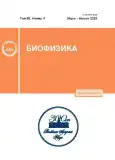Use of peroxiredoxin 6 to prevent liver dysfunction in acute kidney injury
- Autores: Gordeeva A.E1, Kurganova E.A2, Novoselov V.I1
-
Afiliações:
- Institute of Cell Biophysics, Russian Academy of Sciences
- Pushchino State Natural Science Institute
- Edição: Volume 68, Nº 4 (2023)
- Páginas: 770-779
- Seção: Articles
- URL: https://journals.rcsi.science/0006-3029/article/view/142132
- DOI: https://doi.org/10.31857/S000630292304018X
- EDN: https://elibrary.ru/KNAIRU
- ID: 142132
Citar
Texto integral
Resumo
Palavras-chave
Sobre autores
A. Gordeeva
Institute of Cell Biophysics, Russian Academy of SciencesPushchino, Moscow Region, Russia
E. Kurganova
Pushchino State Natural Science InstitutePushchino, Moscow Region, Russia
V. Novoselov
Institute of Cell Biophysics, Russian Academy of Sciences
Email: novoselov-vi@rambler.ru
Pushchino, Moscow Region, Russia
Bibliografia
- K. Lane, J. J. Dixon, I. MacPhee, et al., Nephrol. Dial. Transplant., 28 (17), 1634 (2013).
- M. E. Grams and H. Rabb, Kidney Int., 81 (10), 942 (2012).
- F. Golab, M. Kadkhodaee, M. Zahmatkesh, et al., Kidney Int., 8, 783 (2009).
- А. Ю. Николаев, Эффективная фармакотерапия, 44, 22 (2013).
- S. W. Park, S. W. C. Chen, M. Kim, et al., Lab. Invest., 91, 63 (2011).
- Y. Shang, S. M. Hewage, Ch. U. B. Wijerathne, et al., Front. Med. (Lausanne) 7, 201 (2020).
- J. V. Bonventre and A. Zuk, Kidney Int., 66, 480 (2004).
- M. Serteser, T. Koken, A. Kahraman, et al., FACS J. Surg. Res., 107, 234 (2002).
- E. Y. Plotnikov, A. V. Kazachenko, M. Y. Vyssokikh, et al., Kidney Int., 72 (12), 1493 (2007).
- E. Fadillioglu, Z. Kurcer, H. Parlakpinar, et al., Arch. Pharm. Res., 31 (6), 705 (2008).
- M. H. Emre, H. Erdogan, and E. Fadillioglu, Gen. Physiol. Biophys., 25, 195 (2006).
- А. Е. Гордеева, Э. А. Курганова и В. И. Новоселов, Биофизика, 66 (5) 985 (2021).
- Z.-Y. Fu, Z.-J. Wu, J.-H. Zheng, et al., Drug Design Dev. Therapy, 14, 175 (2020).
- J. Kaur, T. Kaur, et al., Drug Dev. Res., 82, 412 (2021).
- М. Г. Шарапов, А. Е. Гордеева и др., Биофизика, 62, 1208 (2017).
- М. Г. Шарапов, Е. Е. Фесенко, В. И. Новоселов, Биофизика, 63, 734 (2018).
- Y. Manevich, T. Shuvaeva, et al., Arch. Biochem. Biophys., 485, 139 (2009).
- M. G. Sharapov, P. V. Glushkova, et al. Arch. Biochem. Biophys., 702, 108830 (2021).
- R. L. Metha, J. Bouchard, et al., Intensive Care Med., 37, 241 (2011).
- Ostermann and R. W. Chang, Crit. Care, 13, 142 (2009).
- T. Shoji, A. Wada, K. Inoue, et al., Nephron, 105, 99 (2007).
- N. Salem, E. A. Salem, A. M. Maarouf, et al., Ren. Fail., 32 (8), 959 (2010).
- A. Baquerizo, D. Anselmo, and C. Shackleton, Transplantation, 75 (12) 2007 (2003).
- Z. T. Rosenkrans, T. Sun, D. Jiang, et al., Adv. Sci., 7, 2000420 (2020).
- K. Minami, S. Bae, H. Uehara, et al. Am. J. Transpl., 20, 1527 (2020).
- R. G. Goncharov, K. A. Rogov, A. A. Temnov, et al., Cell Tissue Res., 378 (2), 319 (2019).
- X. Wang, S. A. Phelan, K. Forsman-Semb, et al., J. Biol. Chem., 278, 25179 (2003).
Arquivos suplementares









